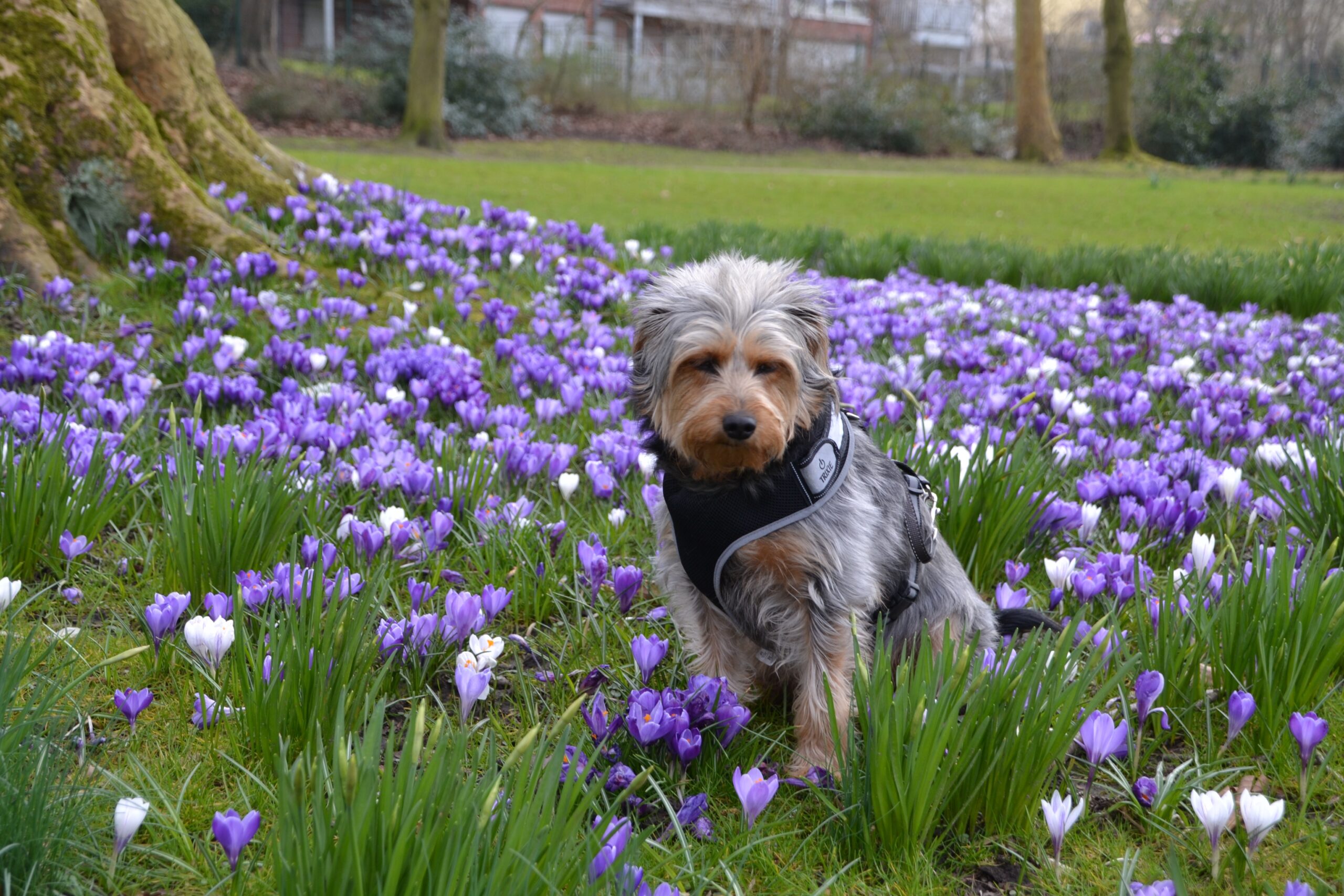Key Takeaways
- Discover which native California plants are safe and beneficial for pets in small gardens.
- Learn how to identify common toxic plants to avoid in pet-friendly spaces.
- Explore the advantages of using native plants for both pet safety and garden health.
- Get specific examples of non-toxic native plants ideal for the SF Bay Area’s unique climate.
- Understand how to design a garden that balances aesthetic appeal with the well-being of your pets.
California Native Drought Tolerant Flowering Plants That Are Non-Toxic to Dogs & Cats:
| Plant Name | Description | Care Tips | Pet-Friendly (for cats & dogs) | Drought Tolerant | Perennial |
|---|---|---|---|---|---|
| Alyssum | Low-growing plant with small, fragrant flowers | Full sun, moderate watering | 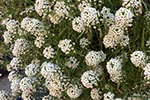 | Yes | Yes |
| Aster | Tall, upright plant with daisy-like flowers | Full sun, moderate watering | 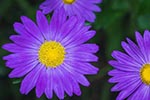 | Yes | Yes |
| Chinese Houses | Fragrant, drought-tolerant plant with purple flowers | Full sun to partial shade in rich, moist soil |  | No | No |
| Clarkia | Fragrant, drought-tolerant plant with purple flowers | Full sun, low watering | 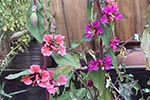 | Yes | Yes |
| Fuchsia | Fragrant, drought-tolerant plant with purple flowers | Full sun, low watering | 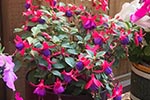 | Yes | Yes |
| Globe Gilia | Fragrant, drought-tolerant plant with purple flowers clusters | Full sun, low watering | 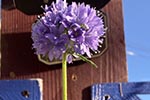 | Yes | Yes |
| Lacy Phacelia | Fragrant, drought-tolerant plant with purple flowers | Full sun, low watering | 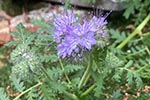 | Yes | Yes |
| Mallow | Tree mallow is drought-tolerant plant with magenta flowers. | Full sun, low watering | 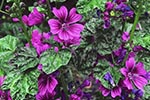 | Yes | Yes |
| Orchid | Exotic, long-lasting flowers with a wide variety of colors and shapes | Bright indirect light, moderate watering | 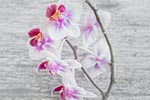 | Yes | No |
| Pansy | Low-growing plant with large, colorful flowers, example: Johnny Jumps | Full sun, moderate watering | 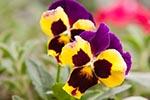 | Yes | Yes |
| Petunia | Trailing or mounding plant with trumpet-shaped flowers | Full sun, moderate watering |  | Yes | Yes |
| Rose | CA Wild Rose: Thorny shrub with fragrant, showy flowers | Full sun, moderate watering | 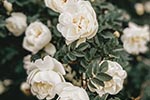 | Yes | Yes |
| Sage/Salvia | Tall, upright plant with daisy-like flowers in various colors | Full sun, moderate watering | 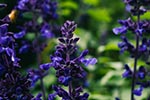 | Yes | Yes |
| Snapdragons | Tall, upright plant with daisy-like flowers in various colors | Full sun, moderate watering | 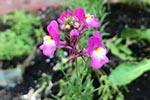 | No | Yes |
| Sunflower | Tall, upright plant with large, bright yellow flowers known for its savory seeds | Full sun, moderate watering | 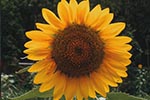 | Yes | Yes |
These flowering plants are safe for both cats and dogs, making them ideal for pet-friendly homes. They are also drought-tolerant and perennial, making them suitable for low-maintenance gardens. Keep in mind that even if a plant is designated as pet safe or dog and cat friendly, that doesn’t mean that it is suitable for mass consumption. The plants that are bold are ones that we have created specific care pages. Click on the name in bold to navigate to the individual plant page with tips and pointers. All of the flowers listed above except roses and orchids are plants we have grown successfully in Lovie’s Pet Safe Garden in Northern California. I have only seen people grow orchids indoors in the Greater Bay Area as it is not very humid here. I think orchids would be a great option for an indoor sensory garden for indoor cats.
Thriving Pet-Safe Gardens in the San Francisco Bay Area
Creating a garden that’s both beautiful and safe for our furry friends is a rewarding challenge, especially in the San Francisco Bay Area where outdoor space can be limited. But don’t worry, with a bit of know-how, you can transform even the smallest of spaces into a pet paradise that’s teeming with native plants. This guide will walk you through the process, ensuring that your garden not only thrives but also keeps your pets wagging their tails with joy.
Why Native Plants Are Paws for Thought
When it comes to gardening with pets in mind, native plants offer a multitude of benefits. They’re adapted to our local climate, which means they’re hardier and require less water – a big plus in our drought-prone region. More importantly, they’re less likely to pose a threat to your pets. Many non-native plants can be toxic to animals, but by choosing species that are indigenous to California, you’re reducing that risk significantly.
Transforming Small Spaces Into Pet Havens
Don’t let a small yard deter you. With some creativity, even a compact garden can become a sanctuary for your pets and local wildlife. The key is to select plants that serve multiple purposes – like providing shade, being resilient to a little rough play, and of course, being non-toxic to your pets.
Choosing the Right Pet-Friendly Flora
Understanding the Risks of Common Plants
Before we dive into what you should plant, let’s talk about what to avoid. Certain popular plants can be dangerous to pets if ingested. For example, common plants that are dangerous to pets.
- Aloe vera can cause vomiting and diarrhea in cats and dogs.
- Daffodils, when ingested, can lead to serious gastrointestinal issues.
- Sago palm is highly toxic and can be fatal if pets consume any part of the plant.
Therefore, it’s essential to do your research or consult with a professional before adding new plants to your garden.
Selecting Non-Toxic Native Plants
Now, let’s focus on what you can grow. The good news is, there are plenty of native California plants that are safe for pets. When choosing plants for your garden, consider these criteria:
- They should be non-toxic to pets.
- They should be hardy and able to thrive in the local climate.
- They should be low-maintenance, especially in small spaces.
For example, pineapple sage is a great drought-tolerant choice. It smells great to us and hummingbirds, repel rats and it’s also safe for pets. Plus, its vibrant red flora will add a splash pizzazz to your garden.
The Benefits of Local Flora for Small Garden Spaces
Choosing local flora isn’t just about pet safety – it’s also about garden sustainability. Native plants are already adapted to the local environment, which means they’re more likely to thrive with minimal care. This is particularly important in small spaces where every plant needs to pull its weight in terms of both aesthetics and functionality.
Native plants also support local ecosystems, providing food and habitat for native insects and birds. By including these plants in your garden, you’re contributing to the health of the environment as a whole, which is something you and your pets can feel good about.
35 Flavors: California Native Plants That Are Safe for Dogs, Cats & Horses
The following list of plants have been verified with the ASPCA list as non-toxic to dogs, cats and horses AND they are all California native plants.
- California Pitcher Plant
- California Hemlock
- Camellia
- Clarkia
- Hagbrier
- Haws
- Haws Apple
- Hawthorn
- Hemlock Tree
- Hummingbird Sage
- Mahonia
- Moss Campion
- Moss Fern
- Moss Phlox
- Mossy Campion
- Mountain Camellia
- Mountain Grape
- Mulberry Bush Greenbrier
- Mulberry Tree
- Nasturtium
- Nerve Plant
- Night Blooming Cereus
- Oregon Grape
- Red Hawthorne
- Red Maple
- Red Veined Prayer
- Roosevelt Fern
- California Pitcher Plant
- Seaside Daisy
- Snapdragons
- California Spider Fern
- California Sunflower
- California Tree Poppy
- Weeping Bottlebrush
- Whitman Fern
Let’s take a closer look at three fan favorites:
Perfect Perennials: The Hummingbird Sage
Another pet-friendly native worth considering is the Hummingbird Sage (Salvia spathacea). This sage variety offers fragrant foliage and tubular flowers that, as the name suggests, are a favorite of hummingbirds. Its robust nature means it can handle the occasional romp from a playful pup, and its drought tolerance makes it a low-maintenance choice for gardeners. Most importantly, it’s safe for pets, allowing them to sniff around without any risk.
Hummingbird Sage not only enhances your garden’s visual appeal but also plays a vital role in the local ecosystem by supporting pollinators. When planting, give this sage room to spread out and consider its height, as it can grow quite tall – a great way to add structure to your garden’s design.
Example: Plant the Hummingbird Sage in clusters to create a naturalistic look, and pair it with low-growing groundcovers to provide a layered effect. This approach maximizes the visual impact and supports a variety of wildlife.
The beauty of these native perennials is that they’re accustomed to our local soil and weather patterns, meaning they’ll thrive with minimal fuss. This lets you spend less time worrying about your plants and more time enjoying the garden with your furry companions.
Sustaining Birds and Pets with Seaside Daisy
Imagine a plant that offers a feast for the eyes and is a buffet for local wildlife, yet is completely safe for your pets. The Seaside Daisy (Erigeron glaucus) is one such gem. Thriving in the coastal conditions of the SF Bay Area, this hardy perennial brings a cheerful splash of lavender to your garden. It’s not only non-toxic to dogs and cats, but it also attracts butterflies and birds, creating a lively outdoor scene that will delight both you and your pets.
Evergreen Elegance: The Island Snapdragon
For year-round greenery, the Island Snapdragon (Gambelia speciosa) is a top choice. This evergreen shrub provides a sturdy backdrop for your garden, with the added bonus of vibrant red flowers that attract hummingbirds. Pet owners can breathe easy knowing that this plant poses no threat to their animals, and its resilience means it can withstand the occasional chase or game of fetch.
Designing Your Pet-Friendly Outdoor Sanctuary
When designing a garden that’s safe for pets and pleasing to the eye, consider each plant’s needs and how they’ll interact with your pets. Place sturdier plants like the Island Snapdragon along paths where pets may run, and use more delicate species in raised beds or areas that are off-limits to your four-legged friends.
Weathering the Elements: Best Positioning for Plant Health and Pet Safety
Positioning is key in a pet-friendly garden. You want to ensure that plants get the right amount of sun and shade, not just for their health, but also to create safe spots for pets to rest. For instance, a Seaside Daisy might thrive in a sunny spot, providing a soft resting place for your pet, while a Hummingbird Sage may offer a cool, shaded nook on hotter days.
Combining Aesthetics and Functionality: Hardscape Elements
Integrating hardscape elements like stone pathways or decorative rocks can provide structure to your garden while also directing pet traffic. These elements help to keep pets away from more delicate plants and can be used to create boundaries that are both visually pleasing and functional.
Consider using materials that are comfortable for paws and can withstand the occasional dig. Pea gravel or smooth flagstones are excellent choices that also add a touch of elegance to your outdoor space.
Example: A winding stone path not only adds charm to your garden but also encourages pets to follow a designated route, keeping them away from sensitive areas.
Remember, the goal is to create a space that is harmonious for both plants and pets, blending their needs seamlessly into the design.
Ensuring Plant and Pet Hydration: Water Features Considerations
Water features can be a delightful addition to any garden, but when pets are involved, safety is paramount. A shallow water feature can serve as a drinking spot for pets and birds alike, but make sure it’s safe for pets to access and that the water is clean.
It’s also important to ensure that the water feature isn’t deep enough to pose a drowning risk for smaller pets. A simple birdbath or a shallow fountain can provide the sights and sounds of water without the worry.
Building Boundaries: Fencing for Safety and Style
Fencing is essential in a pet-friendly garden, not just to keep your pets in, but also to keep wildlife out. Choose fencing that complements the style of your garden while also being secure and tall enough to prevent any escape artists from getting out.
Mesh or picket fencing can be a visually pleasing and effective option, and adding a border of sturdy plants like the Island Snapdragon can enhance the barrier while adding to the garden’s aesthetic.
Spotlight on Accessibility: Pathways and Pet Mobility
Pathways are not just for human use; they also guide your pets through the garden. Ensure pathways are wide enough for your pets to navigate comfortably, and use materials that are gentle on their paws. Smooth flagstones set in grass can provide a pleasing path for both you and your pets.
Accessibility is also about making sure there are no sharp edges or toxic mulches used in your garden that could harm your pets. Opt for pet-friendly options like cedar chips or pine straw, which are safe if ingested in small amounts.
Plant Care and Pet Welfare: Balancing Acts
Caring for your garden means more than just keeping your plants healthy; it also involves ensuring your pets’ safety. Regular maintenance, such as trimming back overgrowth and checking for pests, helps prevent any hidden dangers to your pets. Additionally, using pet-safe pest control methods is critical to keeping both your plants and pets free from harm.
Deterring Pests Without Harming Pets
One of the trickiest parts of gardening with pets is managing pests without using chemicals that could harm your furry companions. The good news is that there are plenty of natural alternatives that can keep pests at bay without putting pets at risk. For example, introducing beneficial insects like ladybugs can help control aphid populations, and using diatomaceous earth around plants can deter slugs and snails without the need for toxic slug bait.
Always read labels carefully and choose pest control products that are marked as safe for pets. And remember, the best defense against pests is a healthy garden, so keep your plants robust with proper care and they’ll be less likely to succumb to infestations.
Seasonal Care: Adjusting Your Garden Routine for Year-Round Enjoyment
Each season brings its own set of gardening tasks, and when pets are part of the equation, it’s important to adjust your routine accordingly. In the spring, prepare your garden beds with pet-safe fertilizers and mulch (no cocoa). Summer might require extra watering to keep both plants and pets hydrated. Come fall, it’s time to prune and clean up any debris to minimize hiding spots for pests. And in winter, protect your plants from frost while ensuring that outdoor pets have a warm shelter.
By staying on top of these seasonal tasks, you can ensure that your garden remains a safe and enjoyable space for your pets all year round.
Frequently Asked Questions
How do I know if a plant is toxic to my pet?
The best way to determine if a plant is toxic to your pet is to consult reliable resources such as the ASPCA’s list of toxic and non-toxic plants. You can also talk to your veterinarian or a local plant nursery expert. When in doubt, it’s best to err on the side of caution and avoid planting anything that might be harmful.
Can pets enjoy the garden if it has non-native plants?
Pets can still enjoy a garden with non-native plants, as long as those plants are non-toxic and not invasive. It’s crucial to do your research and select plants that won’t pose a threat to your pets’ health. However, remember that native plants often require less maintenance and support local ecosystems, making them a more sustainable choice in the long run.
How can I create a dog-friendly grass alternative in a small space?
If you’re looking for a dog-friendly grass alternative for a small space, consider using clover, artificial turf, or a durable ground cover like creeping thyme. These options are resilient to wear and tear, require less maintenance than traditional grass, and are gentle on your pet’s paws.
What should I consider when adding water features in a pet-friendly garden?
When adding water features to a pet-friendly garden, safety is the top priority. Choose shallow designs that pets can safely access and exit. Keep the water clean to prevent the spread of bacteria, and avoid using chemicals that could be harmful if ingested by your pets.
Discover a variety of Pet Friendly Native California Plants that are perfect for small gardens in the SF Bay Area, ensuring a safe and welcoming environment for your furry friends.
Citations:
[1] https://www.gardendesign.com/annuals/vs-perennials.html
[2] https://www.marthastewart.com/8380132/perennial-vs-annual-definition-plants
[3] https://www.bhg.com/gardening/flowers/perennials/difference-between-annual-and-perennial-plants/
[4] https://www.gardenheights.com/single-post/2018/03/30/whats-the-difference-between-perennial-and-annual-plants
[5] https://www.realsimple.com/home-organizing/gardening/outdoor/perennials-vs-annuals
